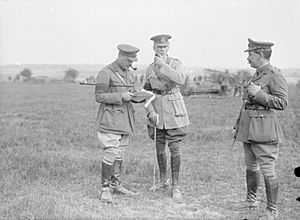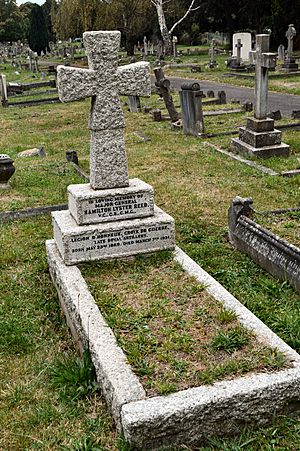Hamilton Reed facts for kids
Quick facts for kids
Hamilton Reed
|
|
|---|---|

Group portrait including Hamilton Lyster Reed (centre)
|
|
| Born | 23 May 1869 Dublin, Ireland |
| Died | 7 March 1931 (aged 61) South Kensington, London |
| Buried | |
| Allegiance | |
| Service/ |
|
| Years of service | 1888 - 1919 |
| Rank | Major General |
| Unit | Royal Artillery |
| Commands held | 15th (Scottish) Division 52nd (Lowland) Division |
| Battles/wars | Second Boer War First World War |
| Awards | Order of the Bath Order of St Michael and St George Croix de Guerre (France) |
| Relations | Sir Andrew Reed (father) Harry Hammon Lyster VC (uncle) |
Major General Hamilton Lyster Reed (born May 23, 1869 – died March 7, 1931) was a brave Irish British Army officer. He is famous for receiving the Victoria Cross (VC). This is the highest award given for incredible bravery in battle to British and Commonwealth soldiers.
Contents
Early Life and Education
Hamilton Reed was born in Dublin, Ireland. His grandfather was Hamilton Lyster, and his father, Sir Andrew Reed, was a well-known police official.
Hamilton studied at the Royal Military Academy, Woolwich. He joined the Royal Field Artillery as a second lieutenant on February 17, 1888.
Military Career
Reed quickly moved up the ranks. He became a lieutenant in 1891 and a captain in 1898. When the Second Boer War started in South Africa in late 1899, he went there to serve.
He was part of the force that helped free the town of Ladysmith. During the Battle of Colenso on December 15, 1899, he was wounded.
His Victoria Cross Story
Captain Reed was 30 years old during the Battle of Colenso. The soldiers operating the big guns of the 14th and 66th Batteries were all hurt or forced to leave their positions. The guns were left alone and unprotected.
Captain Reed heard about the problem. He quickly brought three teams of horses from his own battery. He wanted to see if he could help save the abandoned guns.
He was wounded as he rode towards the guns. Five of the thirteen men with him were also wounded, and one was killed. Thirteen out of twenty-one horses were also killed before they even got halfway to the guns. Because of the heavy enemy fire, he had to turn back. Even though he couldn't reach the guns, his incredible bravery and attempt to save them earned him the Victoria Cross.
Later Service in the Boer War
After the main fighting ended, the Boer War changed into a guerrilla war in late 1900. During this time, Captain Reed worked as a Staff Officer. He was a Deputy Assistant Adjutant-General starting in June 1901.
The war officially ended in June 1902. Reed left South Africa and returned to England the following month.
Further Military Service
Hamilton Reed continued his military career. He worked with the Turkish Army during the Balkan Wars. He also served with the British Army throughout the First World War.
After the war, he became the General Officer Commanding of the 52nd (Lowland) Infantry Division. He held this important position from June 1923 until he retired in June 1927.
He passed away in London on March 7, 1931.
Family Life
Hamilton Reed had a son named Andrew. Sadly, Andrew was killed in the Battle of France while serving with the RAF during World War II.
His Victoria Cross Medal
Hamilton Reed's Victoria Cross medal is now part of the Lord Ashcroft collection. This is a famous collection of military medals.


